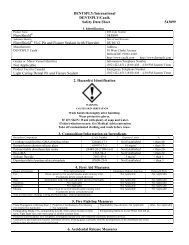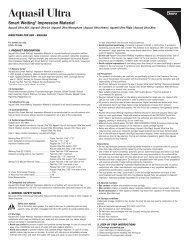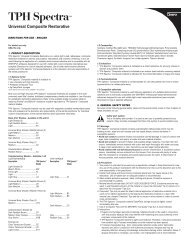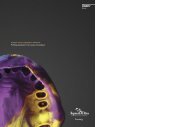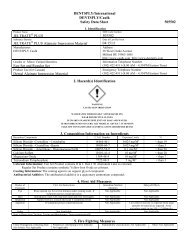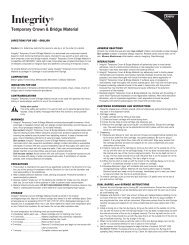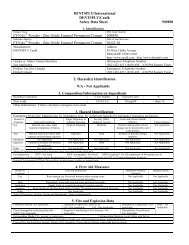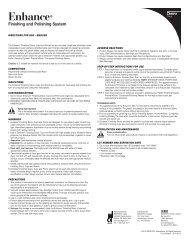Indirect and Direct Restorative Protocols - Caulk
Indirect and Direct Restorative Protocols - Caulk
Indirect and Direct Restorative Protocols - Caulk
You also want an ePaper? Increase the reach of your titles
YUMPU automatically turns print PDFs into web optimized ePapers that Google loves.
› PRINCIPLES & PRACTICES<br />
Cementation Guidelines:<br />
Clinical Recommendations<br />
<strong>and</strong> Requisites<br />
› Abstract:<br />
Cementation of an indirect<br />
restoration involves numerous<br />
variables that include the<br />
luting material itself <strong>and</strong> the<br />
clinical technique used to seat<br />
the veneer, crown, bridge,<br />
or inlay/onlay. Composite<br />
resin cements are often used<br />
in conjunction with dental<br />
adhesives <strong>and</strong> chemically<br />
bond to numerous restorative<br />
materials, facilitating their<br />
adaptation to a properly<br />
conditioned tooth surface. This<br />
presentation discusses a series<br />
of considerations <strong>and</strong> clinical<br />
requisites that can aid the<br />
practitioner in this important<br />
phase of treatment.<br />
In fixed prosthodontics, the clinician’s<br />
ability to achieve an aesthetic,<br />
functional outcome depends<br />
on a variety of factors that<br />
include the cementation protocol.<br />
The luting cement used in such procedures<br />
has to possess high compressive<br />
<strong>and</strong> tensile strengths in addition to serving<br />
as an adherent between the natural<br />
tooth structures <strong>and</strong> the selected restorative<br />
material. Among numerous other<br />
favorable characteristics of an ideal cement<br />
are its biocompatibility, radiopacity,<br />
ease of delivery (eg, h<strong>and</strong>ling, working<br />
time), <strong>and</strong> low film thickness. For<br />
their part, resin cements are categorized<br />
as one of the following based on their activation<br />
mechanism:<br />
■ Light-cured: Recommended for indirect<br />
ceramic or composite restorations<br />
less than 1.5 mm in thickness;<br />
■ Dual-cured: Ideal in porcelain veneers,<br />
composite veneers, <strong>and</strong> other<br />
indications in which light penetration<br />
is limited to 1.5 mm to 2.5 mm<br />
through a dental restoration;<br />
■ Chemically cured: Indicated for restorations<br />
(eg, all-ceramic crowns, metal<br />
restorations, intracoronal restorations<br />
greater than 2.5 mm in thickness) that<br />
will not transmit light upon seating.<br />
Care should always be taken to ensure<br />
that the cement’s shade is compatible with<br />
the desired restoration upon seating of a<br />
ceramic restoration (Figure 1). An ideal<br />
resin cement will possess strong adhesive<br />
properties <strong>and</strong> marginal integrity, <strong>and</strong> will<br />
protect against marginal microleakage (see<br />
Sidebar). Furthermore, its flow will be defined<br />
by the height <strong>and</strong> taper of the preparation;<br />
the higher <strong>and</strong> more cylindrical the<br />
preparation, the less cement will escape,<br />
<strong>and</strong> a greater cement line will be present.<br />
Once the fit of the ceramic restoration<br />
has been confirmed <strong>and</strong> its intaglio surface<br />
has been treated, the prepared teeth should<br />
be conditioned (Figures 2 <strong>and</strong> 3). Today’s<br />
total-etch <strong>and</strong> self-etch adhesives simplify<br />
the seating appointment by combining<br />
steps (ie, etching, priming, bonding) previously<br />
involving multiple components. If the<br />
total-etch technique is selected, the clinician<br />
Figure 1. Shade selection of the resin cement may signifi cantly affect<br />
the fi nal shade of all-ceramic restorations (Courtesy: D. Greenhalgh, Mill<br />
Creek, WA).<br />
Figure 2. Once the tooth is conditioned, the interior of the ceramic restoration<br />
should be treated with a silane coupling agent to improve adhesion<br />
<strong>and</strong> ensure a durable bond.<br />
21



